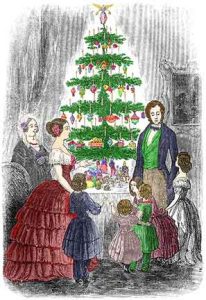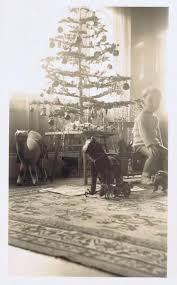Gift Giving
By Karen Osburn, Archivst
 Last Sunday a young girl I know stood up, and with the encouragement of the surrounding adults, announced there were 29 days left until Christmas. We all smiled, she was really enthusiastic and reminded many of us of our anticipation when we were 7 or 8 years old. Then the realization came that we were entering the season of frenzied shopping, wrapping and baking! Oh dear, here we go again!
Last Sunday a young girl I know stood up, and with the encouragement of the surrounding adults, announced there were 29 days left until Christmas. We all smiled, she was really enthusiastic and reminded many of us of our anticipation when we were 7 or 8 years old. Then the realization came that we were entering the season of frenzied shopping, wrapping and baking! Oh dear, here we go again!
This year I moved, after living in the same apartment for 13 years, and I discovered that I had more of almost everything than I needed. The trouble is, I really liked most of it and many of the things were gifts given to me by dear friends who had given a lot of thought to giving me just the right present. The difficulties with deciding what to part with, packing, unpacking and finding places in my new home to display the items I could not part with have given me a whole new outlook on gift giving.
Children can be given books, toys, games, and clothes for Christmas. In most cases they will grow up, and loose interest in them. These items will be stored in wait for younger siblings or perhaps donated to friends and neighbors who have children the appropriate age. Some of these items will make their way to churches, day cares, or places like the Center of Concern, the Salvation Army, the Volunteers of America, Goodwill or the Association for the Blind and Visually Impaired. From there they may be given to children who are less fortunate and to who a second hand toy is as valuable as one that is brand new.
The tradition of giving gifts in December dates back to pagan celebration of the Winter Solstice. Romans celebrated the Solstice with gifts on Saturnalia, a December 17 holiday honoring the God, Saturn. Around 336 A.C. E., as Christianity became more accepted in Rome and Europe December 25 became the acknowledged date of Jesus birth and the gift giving tradition was attributed to the 3 Wise Men who brought gifts to Jesus to celebrate his birth. Another religious figure also became connected to gift giving at this time, St. Nicholas a fourth century Greek Bishop known for his gift giving to the poor. As the celebration of Christmas grew so did the tradition of exchanging gifts. Today, gifts are exchanged in almost every country in the world on Christmas.
 Santa Claus (Sinter Klass in Holland) made his first appearance in America with the arrival of Dutch settlers in the 17th century and by 1870 he’d begun to develop into the jolly man in the red suit we know today, complete with reindeer. Before mass production toys were handmade and they were expensive. Usually only children of wealthy families received fancy toys. Gifts were often apples, oranges, nuts or sweets. Perhaps a porcelain or cloth doll or doll clothes were given to girls while boys may have received marbles or a hoop and stick.
Santa Claus (Sinter Klass in Holland) made his first appearance in America with the arrival of Dutch settlers in the 17th century and by 1870 he’d begun to develop into the jolly man in the red suit we know today, complete with reindeer. Before mass production toys were handmade and they were expensive. Usually only children of wealthy families received fancy toys. Gifts were often apples, oranges, nuts or sweets. Perhaps a porcelain or cloth doll or doll clothes were given to girls while boys may have received marbles or a hoop and stick.
But as mass production became common and prices on goods lowered people began to buy more elaborate gifts for Christmas and the holiday tradition of giving gifts escalated. Today, we have multi-million dollar industries striving to get us to part with a larger portion of our disposable income every year. From toys to gourmet foods to tools and clothing and cars the advertisements encouraging us to spend are constant. Just one year wouldn’t it be nice to relax and have a simpler holiday? Perhaps this is a year for a handmade gift?
